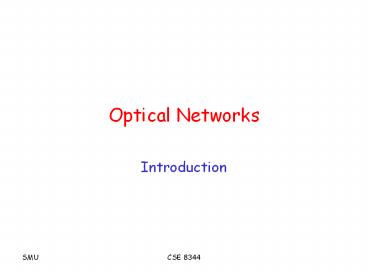Optical Networks - PowerPoint PPT Presentation
Title:
Optical Networks
Description:
... need to be mapped into ATM cells before transporting over WDM using SONET frame ... Least-Used and Most-Used. Least-Used. Record the usage of each wavelength ... – PowerPoint PPT presentation
Number of Views:41
Avg rating:3.0/5.0
Title: Optical Networks
1
Optical Networks
- Introduction
2
Why Optical?
- Bandwidth
- Low cost (0.30/yard)
- Extremely low error rate (10-12 vs. 10-6 for
copper - Low signal attenuation
- Low power requirement
- More secure
3
History
- 1st Generation Copper is transmission medium
- 2nd Generation Optical Fiber (late 80s)
- Higher data rates longer link lengths
- Dense Wavelength-Division Multiplexing (DWDM,
1994) - Fiber exhaust forces DWDM
- Erbium-doped fiber amplifiers (EDFAs) lower DWDM
transmission cost - 3rd Generation Intelligent optical networking
(1999) - Routing and signaling for optical paths
4
Medium Characteristics
- Attenuation
- Wavelength dependent
- 0.85, 1.3, 1.55 micron windows
- Attenuation caused by impurities as well as
scattering - Dispersion
- Inter-modal
- Chromatic
5
Wavelength Division Multiplexing(WDM)
- All the bandwidth could not be used due to the
electronic bottleneck - Two breakthroughs
- WDM
- Erbium-doped fiber amplifier (EDFA)
- WDM vs. FDM
- WDM is passive and hence reliable
- WDM carrier frequency orders of magnitude higher
6
Wavelength Division Multiplexing(WDM)
Frequency-registered transmitters
Receivers
OA
OA
WDM DeMux
WDM Mux
7
Regenerators
- 3R
- Reshaping
- Re-clocking
- Amplification
- 2R
- Reshaping
- Amplification
- 1R (Example EDFA)
- Amplification
8
DWDM Evolution
- Faster (higher speed per wave),
- 40 Gb/s on the horizon
- Thicker (more waves),
- 160 waves possible today
- Longer (link lengths before regeneration)
- A few thousand km possible today
- 160 waves at 10 Gb/s 1.6 Tb/s
- 25 million simultaneous phone calls
- 5 million books per minute
9
WADMs WXC
- WADM (Wave Add-Drop Mux)
- Evolution from p-t-p
- Can add and drop traffic at various locations
- WXC (Wave crossconnect)
- Similar to ADM except that multiple fibers on the
input side with the capability to switch colors
between fibers
10
Enabling Technologies
- Fiber and laser technology
- EDFA
- MEMS (Micro-Electro Mechanical Systems)
- Opaque vs. all-optical networks
11
Current Protocol Stack
IP
ATM
SONET
WDM
12
How Did We Get Here?
- SONET over WDM
- Conventional WDM deployment is using SONET as
standard interface to higher layers - IP over ATM
- IP packets need to be mapped into ATM cells
before transporting over WDM using SONET frame - OEO conversions at every node is easier to build
than all optical switch
13
Problems with Multilayer
- Inefficient
- In IP over ATM over SONET over WDM network, 22
bandwidth used for protocol overhead - Layers often do not work in concert
- Every layer now runs at its own speed. So, low
speed devices cannot fill the wavelength
bandwidth. - Under failure, different layers compete for
protection
14
The Roadmap
15
WDM
- Network Architecture
16
Classes of WDM Networks
- Broadcast-and-select
- Wavelength routed
- Linear lightwave
17
Broadcast-and-Select
w0
Passive Coupler
w1
18
Wavelength Routed
- An OXC is placed at each node
- End users communicate with one another through
lightpaths, which may contain several fiber links
and wavelengths - Two lightpaths are not allowed to have the same
wavelength on the same link.
19
WRN (contd)
- Wavelength converter can be used to convert a
wavelength to another at OXC - Wavelength-convertible network.
- Wavelength converters configured in the network
- A lightpath can occupy different wavelengths
- Wavelength-continuous network
- A lightpath must occupy the same wavelength
20
A WR Network
21
Linear Lightwave Networks
- Granularity of switching in wave bands
- Complexity reduction in switches
- Inseparability
- Channels belonging to the same waveband when
combined on a single fiber cannot be separated
within the network
22
Routing and Wavelength Assignment (RWA)
- To establish a lightpath, need to determine
- A route
- Corresponding wavelengths on the route
- RWA problem can be divided into two sub-problems
- Routing
- Wavelength assignment
- Static vs. dynamic lightpath establishment
23
Static Lightpath Establishment (SLE)
- Suitable for static traffic
- Traffic matrix and network topology are known in
advance - Objective is to minimize the network capacity
needed for the traffic when setting up the
network - Compute a route and assign wavelengths for each
connection in an off-line manner
24
Dynamic Lightpath Establishment (DLE)
- Suitable for dynamic traffic
- Traffic matrix is not known in advance while
network topology is known - Objective is to maximize the network capacity at
any time when a connection request arrives at the
network
25
Routing
- Fixed routing predefine a route for each
lightpath connection - Alternative routing predefine several routes for
each lightpath connection and choose one of them - Exhaust routing use all the possible paths
26
Wavelength Assignment
- For the network with wavelength conversion
capability, wavelength assignment is trivial - For the network with wavelength continuity
constraint, use heuristics
27
Wavelength Assignment under Wavelength Continuity
Constraint
- First-Fit (FF)
- Least-Used (LU)
- Most-Used (MU)
- Max_Sum (MS)
- Relative Capacity Loss (RCL)
28
First-Fit
- All the wavelength are indexed with consecutive
integer numbers - The available wavelength with the lowest index is
assigned
29
Least-Used and Most-Used
- Least-Used
- Record the usage of each wavelength
- Pick up a wavelength, which is least used before,
from the available wavelength pool
- Most-Used
- Record the usage of each wavelength
- Pick up a wavelength, which is most used before,
from the available wavelength pool
30
Max-Sum and RCL
- Fixed routing
- MAX_SUM Chooses the wavelength, such that the
decision will minimize the capacity loss or
maximize the possibility of future connections. - RCL will choose the wavelength which minimize the
relative capacity loss.































